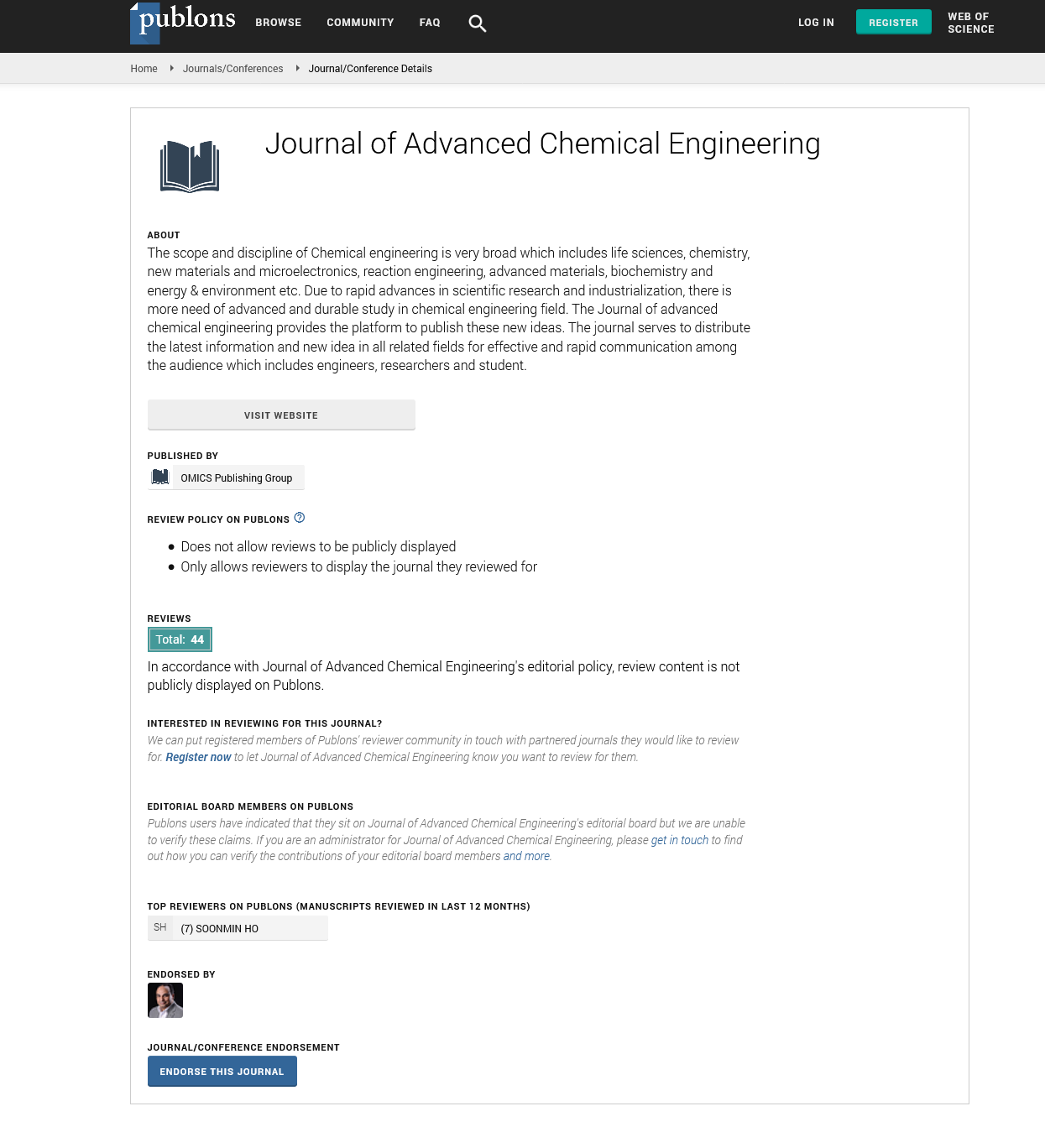Indexed In
- Open J Gate
- Genamics JournalSeek
- Smithers Rapra
- RefSeek
- Directory of Research Journal Indexing (DRJI)
- Hamdard University
- EBSCO A-Z
- OCLC- WorldCat
- Scholarsteer
- Publons
- Geneva Foundation for Medical Education and Research
- Google Scholar
Useful Links
Share This Page
Journal Flyer

Open Access Journals
- Agri and Aquaculture
- Biochemistry
- Bioinformatics & Systems Biology
- Business & Management
- Chemistry
- Clinical Sciences
- Engineering
- Food & Nutrition
- General Science
- Genetics & Molecular Biology
- Immunology & Microbiology
- Medical Sciences
- Neuroscience & Psychology
- Nursing & Health Care
- Pharmaceutical Sciences
Commentary - (2024) Volume 14, Issue 2
Advancements in Process Automation and Control for Precision Fermentation
Vitor Hegemann*Received: 20-May-2024, Manuscript No. ACE-24-26619; Editor assigned: 22-May-2024, Pre QC No. ACE-24-26619 (PQ); Reviewed: 05-Jun-2024, QC No. ACE-24-26619; Revised: 12-Jun-2024, Manuscript No. ACE-24-26619 (R); Published: 19-Jun-2024, DOI: 10.35248/2090-4568.24.14.334
Description
Precision fermentation is a growing field within biotechnology, focusing on the production of specific compounds through the controlled fermentation of microorganisms. This approach is significant for producing high-value chemicals, pharmaceuticals, and food ingredients with exceptional accuracy and efficiency. Innovations in bioreactor design.
Innovations in bioreactor design
Bioreactors are central to the precision fermentation process, serving as the vessels where microorganisms are cultivated to produce desired products. Recent advancements in bioreactor technology have significantly improved the efficiency and control of fermentation processes.
Advanced bioreactor configurations: Modern bioreactors now incorporate innovative configurations such as continuous-flow reactors and staged fermentation systems. Continuous-flow reactors allow for the uninterrupted production of compounds, which can enhance overall process efficiency and yield.
Enhanced monitoring and control systems: The integration of sophisticated monitoring and control systems into bioreactors has been a major development. These systems use sensors and automated controls to continuously measure and adjust variables like temperature, pH, and oxygen levels.
Microbial cell retention and recovery: Advances in bioreactor design include improvements in microbial cell retention and recovery. Techniques such as membrane filtration and centrifugation are employed to separate and concentrate cells, ensuring that microorganisms are retained within the reactor for extended production cycles. This not only enhances productivity but also reduces the need for frequent inoculation.
Metabolic engineering advances
Metabolic engineering involves the modification of microbial metabolic pathways to enhance the production of specific compounds. Recent research has introduced several advanced techniques in this area.
Gene editing and synthetic biology: Advances in gene editing technologies, such as CRISPR-Cas9, have enabled precise modifications to microbial genomes. Researchers can now introduce, delete, or alter specific genes to improve metabolic pathways for the production of target compounds. Synthetic biology approaches allow for the design and implementation of entirely new metabolic pathways within microorganisms, further expanding production capabilities.
Enzyme engineering: Advances in enzyme engineering have led to the development of more efficient and stable enzymes for use in fermentation processes. Researchers are optimizing enzyme activity, stability, and specificity to improve the conversion of substrates into desired products.
Process optimization techniques
Nutrient management: Effective nutrient management is critical for optimizing fermentation processes. Researchers have developed advanced nutrient delivery systems and feeding strategies to ensure that microorganisms receive the optimal balance of nutrients throughout the fermentation cycle. This includes the use of controlled-release nutrient systems and real- time monitoring of nutrient levels.
Energy efficiency: Reducing energy consumption is an important consideration in process optimization. Researchers are exploring ways to improve the energy efficiency of fermentation systems by optimizing heating, cooling, and agitation processes. Energy-efficient bioreactor designs and heat integration techniques contribute to reducing the overall energy footprint of fermentation processes.
Scale-up challenges and solutions
Scaling up fermentation processes from the laboratory to industrial scale presents several challenges. Recent research has focused on addressing these challenges to enable successful large- scale production.
Scale-up modeling: To connect between laboratory and industrial scales, researchers are developing scale-up models that predict how fermentation processes will perform at larger scales. These models account for factors such as heat transfer, mass transfer, and mixing dynamics. Computational fluid dynamics (CFD) and other modeling tools are used to optimize reactor designs and scale-up procedures.
Pilot plant development: Pilot plants play a critical role in transitioning from laboratory experiments to commercial production. Recent advancements in pilot plant design have focused on improving the scalability and efficiency of fermentation processes. Pilot plants allow researchers to test and refine processes on a larger scale, providing valuable data for scaling up to full production.
Applications and future prospects
The advancements in chemical engineering research on precision fermentation have broad applications across various industries. These developments offer new opportunities for sustainable production and resource efficiency.
Pharmaceuticals: Precision fermentation is increasingly used in the production of therapeutic proteins, vaccines, and other pharmaceuticals. The ability to produce complex molecules with high precision has significant implications for drug development and manufacturing.
Food and agriculture: In the food and agriculture sectors, precision fermentation is employed to produce plant-based proteins, flavors, and bio-based fertilizers. These applications contribute to more sustainable and efficient food production systems.
Safety culture: Using a strong safety culture is essential for minimizing risks. This involves encouraging open communication about safety concerns, promoting adherence to safety protocols, and recognizing employees who contribute to maintaining a safe work environment.
Training and education: Ongoing training and education for employees are crucial for ensuring that they are aware of safety procedures, emergency response protocols, and security practices. Regular drills and refresher courses help reinforce these practices and keep staff prepared for potential incidents.
Emergency preparedness: Developing and maintaining comprehensive emergency preparedness plans is essential for responding to safety and security incidents. These plans should include clear procedures for evacuation, communication, and coordination with emergency services.
Citation: Hegemann V (2024) Advancements in Process Automation and Control for Precision Fermentation. Adv Chem Eng. 14.334.
Copyright: © 2024 Hegemann V. This is an open-access article distributed under the terms of the Creative Commons Attribution License, which permits unrestricted use, distribution, and reproduction in any medium, provided the original author and source are credited.

